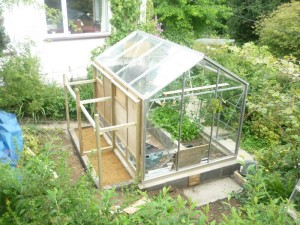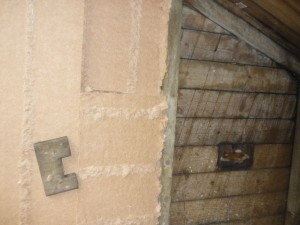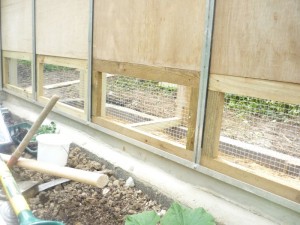20 Jul 2009
A Chicken Greenhouse Update: notes from the cutting edge of permaculture inventiveness/absurdity
 You may remember the piece I wrote a while ago about my plans to build a chicken greenhouse, and my realisation that, in spite of my having spent years teaching this design classic on permaculture courses, nobody I had spoken to had actually seen one. The comments that followed were fascinating, although mostly they concurred, or mentioned ones that people may have glimpsed some time ago, somewhere or other. Well, although I still don’t yet have a functioning chicken house, or even any chickens for that matter, things have moved along a bit, and I thought this would be a good time to bring you up to date with developments at the cutting edge of chicken/greenhouse research.
You may remember the piece I wrote a while ago about my plans to build a chicken greenhouse, and my realisation that, in spite of my having spent years teaching this design classic on permaculture courses, nobody I had spoken to had actually seen one. The comments that followed were fascinating, although mostly they concurred, or mentioned ones that people may have glimpsed some time ago, somewhere or other. Well, although I still don’t yet have a functioning chicken house, or even any chickens for that matter, things have moved along a bit, and I thought this would be a good time to bring you up to date with developments at the cutting edge of chicken/greenhouse research.
The first gem of information which I found somewhere that I now can’t find, was that 1 adult chicken gives of 15w of heat, so 4 chickens give off the equivalent of one 60w lightbulb, which on a winters night in a greenhouse is not to be sniffed at. Of course, given that greenhouses are not exactly the best insulated structures in existence, this may well all be a lot of effort for little gain. However, I persist.
So, the great news is that after a discussion with me and a tour of my work-in-progress chicken greenhouse, my next door neighbour is now building one too, far better thought out and constructed than mine, so my little cul-de-sac is now officially the World Centre for Research into Chicken Greenhouses (or WCRCG as it is known in academic circles). It can surely only be a matter of months before coachloads of men in white coats with clipboards are seen in the street, carefully reverse-engineering our astonishingly efficient chicken greenhouses (either that or coming to take the two of us away for our own protection).
 So, news on mine firstly. I have to be honest, what what with one thing and another, not a great deal has happened since that last post. I really need to take a couple of weeks off just to catch up on projects like this! As readers of the previous piece will recall, I have inherited an existing chicken house which I am ‘retrofitting’ and making fit for purpose. I have begun work on insulating it, using left over Pavatherm from the retrofitting of my kitchen (see right). I will then line it with T&G boards, as Pavatherm would, I’m sure, be great fun to pick at. The idea is to insulate the 5 sides of the chickenhouse that do not join onto the greenhouse, so that more or the heat makes it out. This should be finished soon. Still working on the exact connection between the two, but it will have vents that can open or close.
So, news on mine firstly. I have to be honest, what what with one thing and another, not a great deal has happened since that last post. I really need to take a couple of weeks off just to catch up on projects like this! As readers of the previous piece will recall, I have inherited an existing chicken house which I am ‘retrofitting’ and making fit for purpose. I have begun work on insulating it, using left over Pavatherm from the retrofitting of my kitchen (see right). I will then line it with T&G boards, as Pavatherm would, I’m sure, be great fun to pick at. The idea is to insulate the 5 sides of the chickenhouse that do not join onto the greenhouse, so that more or the heat makes it out. This should be finished soon. Still working on the exact connection between the two, but it will have vents that can open or close.
 My neighbour’s is a far more technically superior attempt (see above). He was already planning to put up a greenhouse, an aluminium framed one he had got hold of, and was also planning to keep chickens, but the concept of a chicken greenhouse seems to have fired his creativity. He glazed the greenhouse apart from the north-facing side, which he panelled instead using plywood held in place by the same clips intended to hold the glazing in. He also plans to put in place a rather impressive but low tech rainwater harvesting system. He has open-and-closeable vents at the top and the bottom (see left) which will enable him to regulate how much heat passed from one to the other.
My neighbour’s is a far more technically superior attempt (see above). He was already planning to put up a greenhouse, an aluminium framed one he had got hold of, and was also planning to keep chickens, but the concept of a chicken greenhouse seems to have fired his creativity. He glazed the greenhouse apart from the north-facing side, which he panelled instead using plywood held in place by the same clips intended to hold the glazing in. He also plans to put in place a rather impressive but low tech rainwater harvesting system. He has open-and-closeable vents at the top and the bottom (see left) which will enable him to regulate how much heat passed from one to the other.
I will keep you updated on developments. Both of us are getting a bit late for putting chickens in them this year, but we’ll see. Any tips, thoughts or enormous research grants are most welcome.
Leo Bakx
20 Jul 3:07pm
Hi Rob,
I have it on reasonably good authority -an architect who designs for vets- that a single horse will produce a 1000 Watts of heat.
As for insulation while preserving light transmission, you might like to consider a fossil carbon product: ETFE. A much better use that just burning the stuff I reckon 🙂 I’m not sure about the difference with glass in embodied energy.
It was used quite successfully and effectively in the Eden Project in Cornwall and for some Olympic sports venues in China.
You could probably retrofit ETFE “cushions” in your greenhouse frame. I have absolutely no idea about cost for “small scale” domestic use of ETFE. Maybe you could persuade the manufacturer to send some samples…
spunsilk_coach
20 Jul 5:20pm
the ammonia in the chicken manure will kill the plants…
so good luck with that 🙂
dollie
21 Jul 12:46am
chicken manure is a terrific fertilizer BUT needs to be composted first. frequent cleaning under
roosts and spot scraping of floors will make wonderful fertilizer next spring. You just forge ahead and don’t let them scare you……
mike jones
21 Jul 4:43pm
I’ve just heard that Christian of Beenleigh Meadow is to get rid of his chickens soon, so they are looking for a new home.
His no is 07760487398.
Bandidoz
23 Jul 6:06pm
Erm, what exactly are the shortcomings of a standard chicken shed? Please educate me!
Reto
24 Jul 8:34am
An example of a working CGH (if you own some land) is the one they built on the Balmeggberg>/a> which is located 1000 metres above sea level. Even in the rough last winter season the temperature was always above 0 degree.
I guess insulation is the critical point which will possibly be a bit of a challenge on free standing buildings.
LouiseF
24 Jul 12:18pm
No shortcomings, Bandidoz, but one idea of permaculture is to make use of outputs from one area as inputs to another, called linking. Hence wasted heat from chickens can be used as input to heat (rather than creating additional heat input). In theory.
Rob, Patrick Whitefield also mentioned to us on his PD course recently that some of these ideas are more theoretical than many admit. I’m sure he’d put a picture in the next edition if it all works out for you!
Tori Cole
24 Jul 3:51pm
I’m so excited to see find this blog! I have been wanting to install both chickens and a greenhouse at my new house and I can’t wait to see the progress of combining the two together. I hope it goes well.
Mark Pemburn
24 Jul 6:12pm
Before you go installing chickens in your greenhouse, it might be good to learn a little bit more about chickens and their needs.
Patrick
24 Jul 6:45pm
Remember that the heat transfer will happen in both directions, so on a sunny day the hot greenhouse will overheat a well insulated chicken coop. Most chickens (especially UK breeds) are hardy but get stressed in very hot (30 degrees plus) conditions leading to health problems and death.This is why in the middle of summer they like to dust bathe and lie still pressed to the ground to cool off.
Be careful that your goal of giant tomatoes doesn’t manifest as roast rooster!
Seaseal
25 Jul 8:04pm
Chickens produce heat several ways. One great way is the manure in the compost–that generates heat just as chickens produce body heat.
The heat from digestion of foods (even manure being decomposed) is measured in calories–calor= heat.
With a thoughtful study of where to put the compost, the heat from the chicken manure can be funneled into the greenhouse area.
I just took a solar food dehydration class so I’d check the designs for those to get ideas of how to collect and vent heat for the greenhouses.
I’ll be starting the WCRCG No. Amer. Annex soon.
terrie
26 Jul 5:36am
I’ve wondered about Patrick’s point as well…here in Northern CA, I’m sure that a greenhouse would overheat a hen house far too much.
Leigh
27 Jul 10:01pm
I think the design would work great for a WINTER coop/roost….which is when I’d be using a greenhouse anyway. Here in Arkansas, my chickens get too hot just out in their pasture under trees in the summer, much less close to any greenhouse. And plants would croak in a summer greenhouse too without some major shadecloth or deciduous tree cover. But in the winter, the hens would love that warmth.
Regarding some previous comments – I believe the design takes into consideration that the chix and the plants must be kept separate (thus no prob. with uncomposted poo on plants…which would burn them of course…or chickens devouring plants, which they of course would if not fenced off!)
Can’t wait to hear how it turns out!
Seppo
28 Jul 3:00pm
I don’t know the first thing about these things, but Seaseal mentioned composting the chicken manure inside the greenhouse. It led me to think of composting others stuff in there, too. Put all the compost you produce inside (including a composting toilet)?
And maybe you have other animals, too. A dog? (a dog greenhouse 🙂
In the Eastern Finland they used to have horses and cows downstairs producing heat, and people living above them.
What about those heat reflecting films you put on the glass?
Just some ideas that come to my mind.
Greenpa
28 Jul 11:47pm
I am reminded rather forcibly of the attempts to design and commercially produce a “flying car”.
It’s been “just around the corner!” for at least 50 years now.
And, in case you hadn’t noticed, all the attempts failed. Lots of fun photos if you google flying car.
A new one is now on the horizon; a couple fellows, over pizza and beer, I think, decided that the problems all arose from starting with a car, and trying to make it fly.
Their approach is to take a plane; and make it “roadable”.
http://www.terrafugia.com/
And; you’ll be delighted to know; they’ve named it- The Transition®!!
Expect them to sue you soon- despite your precedence. Good publicity. 🙂
Anyway- it does strike me that it might be more successful in the current situation to start with an excellent chicken coop, and graft some greenhouse aspects onto it. Rather than trying to cram chickens, poop, ammonia, dust, scratching, etc, into a greenhouse.
Might be a useful change in thinking.
Franklin
30 Jul 11:03am
Thanks to “Reto” for that link. I really like the Earthship design, whether it’s being used as a home or a greenhouse. What your standard “Greenhouse” lacks is insulation and thermal mass. Minimize heat loss buy insulating all but the south facing glazed area. Also perhaps used raised beds to reduce cold from the floor and water container with “Dark” water “i.e. food colouring)at the back of the greenhouse as thermal mass to store the heat. As for the chickens, why not just put them to work in the green house or poly tunnel over the winter as a chicken tractor (ref http://www.gardengirltv.com )
Lisa Richards
31 Jul 4:35pm
Walter Jeffries in Vermont did a chicken coop greenhouse years ago:
http://sugarmtnfarm.com/blog/2005/12/winter-hen-coop.html
Denny
31 Jul 4:45pm
I have a chicken coop greenhouse! You can see it here: http://www.flickr.com/photos/geekinthegarden/3399869754/in/photostream/
Now, truth be told we built it this past spring and I’ve only had the chickens in since May so I do not yet know how well it will work. I’m in mid-Missouri, U.S. so I’ll find out this winter. We tend to hover in the 20s and 30s fahrenheit during much of the winter with some nights down at 0.
Something to be remembered in discussing this combo is that it is about more than temperature exchange!! Much more. There is also carbon dioxide though the benefits from that might also be debatable. But, there is also the benefit of proximity of chicken manure and bedding to the greenhouse and compost. I can easily exchange vegetable waste from the greenhouse with the chickens as I move their manured bedding into the compost which can be just outside or even inside the greenhouse. Also, we are collecting rainwater from the two roofs. In the greenhouse it will be stored in black barrels and this will hopefully also help keep the greenhouse warm even as the water is used for the chickens and plants. We’ll be putting a water spigot right in the coop for easy access.
I can definitely say, after this spring and summer, having the different elements all together makes the gardening-watering – composting-coop care more convenient. That alone makes the connection worth it. If the heat/carbon dioxide exchange work to any measurable degree than I’ll be thrilled. That’s just the icing on the cake.
Madison
3 Aug 6:57am
Re: excessive summer heat in green houses…
My parent’s green house, a low tech plastic affair, does have one very relevant feature that could be well used in this sort of application. When the temps get up in the summertime the two vents on top automatically open above a certain temp. Not entirely sure about how it works but it is non powered and is a result of some sort of composite material changing shape at different rates in response to the temperature.
Insulation and glazing aside, both of which are good things when deployed in cooler climates it would also makes sense to have vents at the bottom to draw air up. Plus an out-run where the hens could take advantage of if they wanted a temp change.
Lastly, I would have to agree with the comment above that a good CGH might be best designed on top of an established coop design, with the plants as the ones that hitch along for the ride in a warm sunny enclosure.
Best of luck and keep the posts coming!
Denny
5 Aug 4:35pm
Regarding the summer heat, I’ll confirm what Madison said: vents. Not only can the heat be let out of the greenhouse but the vents in the solid wall between the greenhouse and coop can be closed. Also, my chickens free range all day so they are not in the coop except to lay their eggs.
Night Walker
26 Nov 8:04am
Here’s something from “Mother Earth News” magazine, back in the summer of 1986:
Mother’s Bioshelter Greenhouse – This quality greenhouse uses both solar and compost heat and houses rabbits and chickens, including structure, notes on construction, cross sections and floor plans.
http://www.motherearthnews.com/Organic-Gardening/1986-07-01/Bioshelter-Greenhouse.aspx
The entire article is available for free online at the above link.